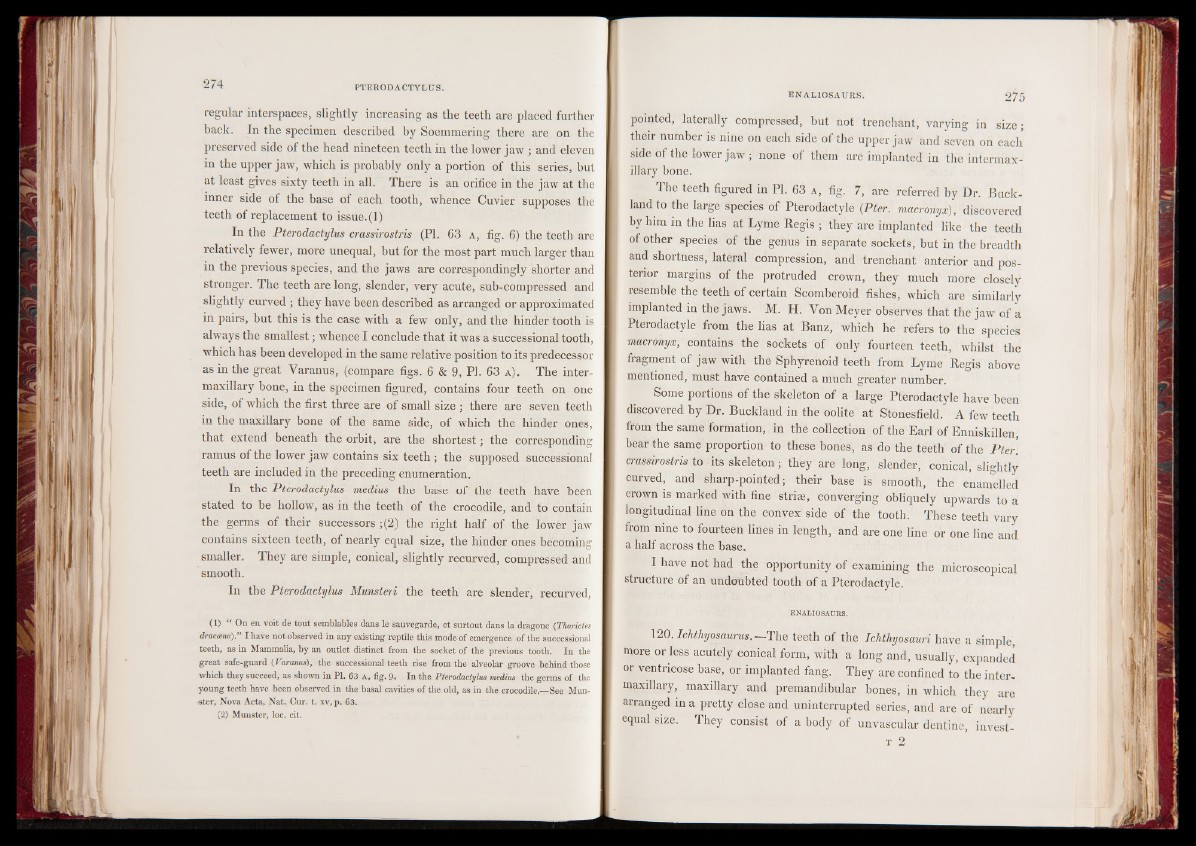
regular interspaces, slightly increasing as the teeth are placed further
back. In the specimen described by Soemmering there are on the
preserved side of the head nineteen teeth in the lower jaw ; and eleven
in the upper jaw, which is probably only a portion of this series, but
at least gives sixty teeth in all. There is an orifice in the jaw at the
inner side of the base of each tooth, whence Cuvier supposes the
teeth of replacement to issue. (1)
In the Pterodactylus crassirostris (PI. 63 a , fig. 6) the teeth are
relatively fewer, more unequal, hut for the most part much larger than
in the previous species, and the jaws are correspondingly shorter and
stronger. The teeth are long, slender, very acute, suh-compressed and
slightly curved ; they have been described as arranged or approximated
in pairs, but this is the case with a few only, and the hinder tooth is
always the smallest; whence I conclude that it was a successional tooth,
which has been developed in the same relative position to its predecessor
as in the great Varanus, (compare figs. 6 & 9, PI. 63 a). The intermaxillary
bone, in the specimen figured, contains four teeth on one
side, of which the first three are of small size ; there are seven teeth
in the maxillary hone of the same side, of which the hinder ones,
that extend beneath the orbit, are the shortest; the corresponding
ramus of the lower jaw contains six teeth ; the supposed successional
teeth are included in the preceding enumeration.
In the Pterodactylus medius the base of the teeth have been
stated to be hollow, as in the teeth of the crocodile, and to contain
the germs of their successors ;(2) the right half of the lower jaw
contains sixteen teeth, of nearly equal size, the hinder ones becoming
smaller. They are simple, conical, slightly recurved, compressed and
smooth.
In the Pterodactylus Munsteri the teeth are slender, recurved,
(1) “ On en voit de tout semblables dans le sauvegarde, et surtout dans la dragone (Thorictes
dracæna).” I have not observed in any existing reptile this mode of emergence of the successional
teeth, as in Mammalia, by an outlet distinct from the socket of the previous tooth. In the
great safe-guard (Varanus), the successional teeth rise from the alveolar groove behind those
which they succeed, as shown in PI. 63 a, fig. 9. In the Pterodactylus medius the germs of the
young teeth have been observed in the basal cavities of the old, as in the crocodile.—See Mun-
-ster, Nova Acta, Nat. Cur. t. xv, p. 63.
(2) Munster, loc. cit.
pointed, laterally compressed, but not trenchant, varying in size;
their number is nine on each side of the upper jaw and seven on each
side of the lower jaw; none of them are implanted in the intermaxillary
bone.
The teeth figured in PI. 63 a , fig. 7, are referred by Dr. Buck-
land to the large species of Pterodactyle (Pter. macronyx), discovered
by him in the lias at Lyme Regis ; they are implanted like the teeth
of other species of the genus in separate sockets, but in the breadth
and shortness, lateral compression, and trenchant anterior and posterior
margins of the protruded crown, they much more closely
resemble the teeth of certain Scomberoid fishes, which are similarly
implanted in the jaws. M. H. Von Meyer observes that the jaw of a
Pterodactyle from the lias at Banz, which he refers to the species
macronyx, contains the sockets of only fourteen teeth, whilst the
fragment of jaw with the Sphyrenoid teeth from Lyme Regis above
mentioned, must have contained a much greater number.
Some portions of the skeleton of a large Pterodactyle have been
discovered by Dr. Buckland in the oolite at Stonesfield. A few teeth
from the same formation, in the collection of the Earl of Enniskillen,
bear the same proportion to these bones, as do the teeth of the Pter.
crassirostris to its skeleton; they are long, slender, conical, slightly
curved, and sharp-pointed; their base is smooth, the enamelled
crown is marked with fine striae, converging obliquely upwards to a
longitudinal line on the convex side of the tooth. These teeth vary
from nine to fourteen lines in length, and are one line or one line and
a half across the base.
I have not had the opportunity of examining the microscopical
structure of an undoubted tooth of a Pterodactyle.
ENALIOSAURS.
120. Ichthyosaurus.—The teeth of the Ichthyosauri have a simple,
more or less acutely conical form, with a long and, usually, expanded
or ventricose base, or implanted fang. They are confined to the intermaxillary,
maxillary and premandibular hones, in which they are
arranged in a pretty close and uninterrupted series, and are of nearly
equal size. They consist of a body of unvascular dentine, investt
2